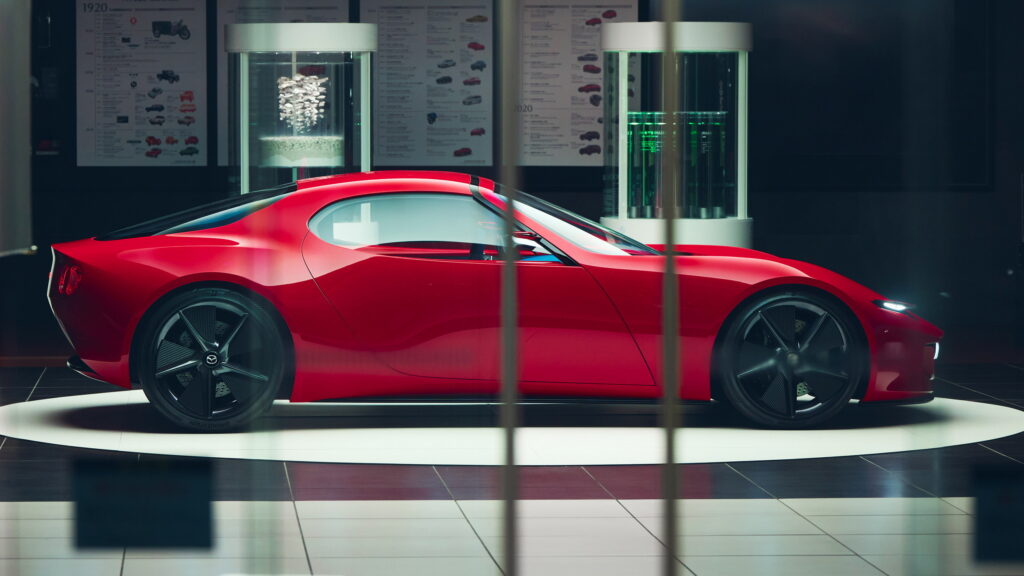Mazda’s RX-7 Successor Meets The One Problem It Can’t Engineer Away
- Mazda CTO says Iconic SP production faces major financial obstacles.
- Rotary engine work continues, but R&D costs stall bespoke sports cars.
- RX-7 successor struggles for survival as new MX-5 arrives this decade.
Since the debut of the Iconic SP concept at the 2023 Japan Mobility Show, Mazda enthusiasts have been waiting for the day it leaves the stand and hits the street. The coupe sparked immediate speculation about a spiritual successor to the RX-7, and top Mazda execs have been eager to keep that hope alive.
Yet, the latest reports suggest that the journey from concept to reality might not be as smooth as fans would like.
More: Mazda Vision-X Compact Might Be A Little Too Friendly
In late 2024, Mazda Design Chief Masashi Nakayama said the Iconic SP was “designed with real intent to turn it into a production model,” a goal echoed by CEO Masahiro Moro: “We still persist in making it happen.” Chief Technical Officer Ryuichi Umeshita later called it “a good successor for the RX-7,” though he admitted the project still needs a sound business case.
How Close Is It to Reality Now?
Our colleagues at Autocar recently spoke with Umeshita to hear how development of the much-anticipated model is progressing. The Chief Technical Officer was candid: “Let me answer personally—that is my dream car. I want to make it real. Technology-wise, I believe it’s possible. The only outstanding issue is financial.”

Earlier this year, Mazda trimmed its planned budget for electrification by half a trillion yen ($3.3B). The company is pursuing a “Multi-Solution” strategy that blends BEV, hybrid, and combustion engines rather than going all-in on electric.
More: Mazda Brings Back Turbo Rotary Engine With Vision-X Coupe
Between developing an EV-specific platform, a new hybrid setup, and the upcoming SkyActiv-Z engine, Mazda’s resources are already stretched thin. In that light, a bespoke sports car might not sit at the top of the spending list.
Rotary Revival With A Turbo
Even so, the idea hasn’t been shelved. The Vision X Coupe concept, unveiled at the 2025 Japan Mobility Show, shows Mazda hasn’t turned its back on the rotary dream.
If anything, it confirms that the company is still invested in the technology that defined some of its most celebrated cars as that study is powered by a hybrid unit with a turbocharged rotary engine.
Umeshita underlined that continuity: “We have re-established the rotary engine development team, and we know that our DNA is in sports cars, so I would never say we gave it up.”

The Vision X Coupe’s plug-in hybrid setup pairs a turbocharged rotary engine with an electric motor for a combined 503 hp (375 kW / 510 PS) and includes carbon-capture technology. By contrast, the Iconic SP’s range-extender system produced 365 hp (272 kW / 370 PS).
More: Over 9,500 People Wanted This Special Miata, 9,300 Missed Out
Mazda’s next step is to cut emissions from the rotary engine further, which could eventually allow it to drive the wheels directly rather than serving solely as a generator. Engineers estimate this evolution will take another “two to three years” of development.
Will the Next MX-5 Carry the Torch?
While Mazda’s design and engineering teams work toward reviving the rotary legacy, the brand’s future in sports cars looks brighter than it has in years.
Alongside the potential RX successor, Mazda has confirmed that the next-generation MX-5 roadster will arrive later this decade. The upcoming Miata will stay true to its lightweight spirit, equipped with a larger-displacement SkyActiv Z engine and, reassuringly, a manual gearbox.
